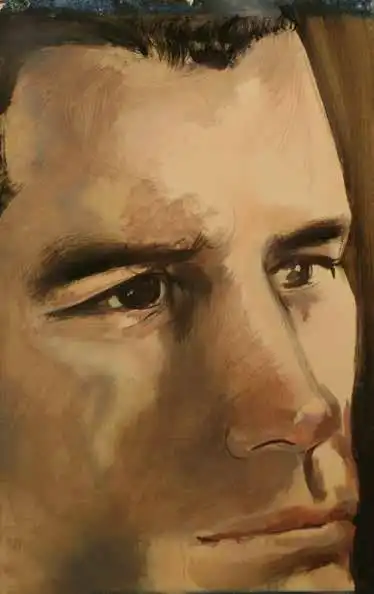
4 minute read
Art Focus Oklahoma Winter 2020

Last year from October 4 th through December 29th, Oklahoma-native Harold Stevenson’s collection of paintings, called The Great Society, was on display at the University of Oklahoma’s Fred Jones Jr. Museum of Art in Norman. The collection was a gift from the artist, an OU art school dropout himself, given to the museum in 2007. This exhibition is the first time the work has been seen together since Stevenson gifted the series. The exhibit follows Stevenson’s death by a year.
Advertisement
The Great Society is an extensive series of portraits of residents living in Idabel, Oklahoma, Stevenson’s hometown, and the surrounding McCurtain County. Stevenson began the project in 1966, after he returned home to Idabel from a successful, artful stint in Paris, France. Composed of 100 large portraits, Stevenson considered The Great Society a single work of art. The collection’s name was a nod to Lyndon B. Johnson’s “Great Society,” the president’s utopian dream, centered around equality and togetherness. That noble vision inspired Stevenson to document his personal great society—the men and women who made up his life in Oklahoma.
The exhibition features 97 out of the 100 paintings. While the exhibition is impressive, the quantity of paintings isn’t obvious. Seeing the nearly 100 paintings all fit within a single space gives the same feeling of surprise one gets from seeing 100 M&Ms in a jar. Suddenly a big, important sounding number seems reasonable and digestible. So, while the exhibition doesn’t feel like 97 paintings, seeing these massive portraits surrounding you, like a maze of faces, is completely enveloping.
The paintings are all extreme close-ups of the individuals’ face; many of the paintings cut off the person’s chin and/or forehead, making the framing uncomfortably close. The feeling of intimacy is intensified by the alive, betweenmoments on the faces, captured forever in the paintings: gazes looking off-frame, half-opened eyes, parted mouths, or general expressions of discontent and vulnerability. Hardly any of the paintings from the collection can be considered flattering, but all of the paintings are undeniably human and, therefore, warm.
The collection’s color palette, framing, and level of detail give each individual a vague-enoughto-be-familiar look. Maybe they look familiar because they’re Oklahoma residents, like many of us, unassuming folks who simply got their portraits painted only some fifty years ago. Some of the subjects probably have family members currently attending their host university. What if these large faces were the faces that made up your childhood town, as they were Stevenson’s?
During the first month of the exhibition, the museum hosted Dr. Samuel Watson, an art professor from the University of Wisconsin Green Bay, who presented a talk on Stevenson’s work as it related to his and his peer’s sexuality called Size Queen: Harold Stevenson and the Politics of Looking Lecture. It offered insight into Stevenson’s life as a gay artist in the 20th century. “He was a man who really loved what he painted,” with The Great Society being “a remarkable testament to love,” says Dr. Watson.
Stevenson grew up in Oklahoma but lived and worked all over the world in his lifetime (while always considering Idabel his true home). However, his first move out of Oklahoma was to New York. Stevenson arrived in New York City to follow his dream of becoming a successful artist in 1949, the same year as Andy Warhol. The two became friends and contemporaries. They were able to fortify each other in owning their homosexuality at a time and place where it was stigmatized as well as criminalized. They remained close friends throughout their careers and lives.
(continued to page 6) Dr. Watson links Jackson Pollock’s use of scale as an influence on Stevenson’s “need to blow things up.” Turns out, the framing in The Great Society feels like one big wide shot

Opposite page and above: Harold Stevenson (U.S., 1929-2018), The Great Society, 1966, Mixed media on paper, 50 ½” x 30”, Fred Jones Jr. Museum of Art, The University of Oklahoma, Norman, Gift of the artist, 2007.
Opposite page and above: Harold Stevenson (U.S., 1929-2018), The Great Society, 1966, Mixed media on paper, 50 ½” x 30”, Fred Jones Jr. Museum of Art, The University of Oklahoma, Norman, Gift of the artist, 2007.


review after seeing his earlier nudes (focusing only on areas smaller than the face, like hands or eyes) from the late fifties and on. Whether his art is zoomed in or simply oversized, like his most famous work, The New Adam (originally intended to be wrapped around all four walls of a gallery room), grand use of scale was a signature of Stevenson’s. Harold Stevenson is a world-famous artist and Oklahoma treasure with rich ties to the Pop Art evolution.
More information about the exhibition may be found on the Fred Jones Jr. Museum of Art website at ou.edu/fjjma. n
Dailey is a production coordinator and freelance writer in Norman, OK. She is a graduate of the University of Oklahoma.



